Summary
- September Swoon is a historically verifiable phenomena.
- Since the Great Depression stock markets have traditionally underperformed.
- Could be due to economic cycles, or could be due to "mental" factors.
- Not a bad idea to sell off before a drop, but if you don't it'd be best to hold on to assets.
It's that time of the year and some investors are wondering if the infamous September Swoon will once again reappear. For those who are unfamiliar with the swoon, it's a purported dip in markets that occurs in September more often than not. Obviously, if markets will indeed take a dip this month, investors would be smart to protect themselves by selling off ahead of the dip.
As odd as it sounds, evidence does suggest that stocks do tend to dip in September. So if the swoon is indeed true, the next big question to ask is why?
Does it have something to do with the global cycle of the economy, or could it have become a sort of mental road bump in the road? We think it's true, and so it becomes true.
As an investor, September is an important month to approach. If there is a September dip, it'd make sense for you to liquidate your portfolio and buy up stocks after they trend downwards. Not only would you protect yourself from losses, but you could also buy stocks on the cheap.
After all, the whole point of investing is to buy low and sell high.
September Swoon: Myth or Fact?
Data suggests that the September Swoon is indeed a fact of the market. Consider this, since 1926, large companies have reported an average gain of 1 percent in every month, except one. Can you guess what month that is?
September, of course. In fact, large companies have suffered a .8 percent decline during September since 1926. So during every other month of the year, stocks tend to trend upwards, but then they suddenly take a stumble come September.
The S&P 500 has also averaged a negative .5 percent through September. And a quick examination of Septembers throughout the years does reveal dips. Let's look at one:
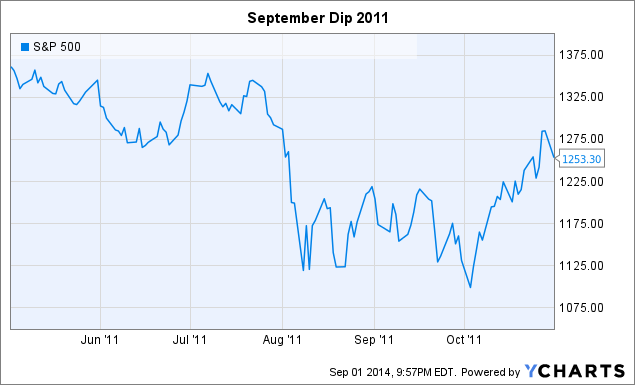
^SPX data by YCharts
Meanwhile, for each month of the year besides September, stocks have risen about 62 percent of the time. For September, gains and losses are split 50-50.
It's interesting to note that for the last several years, trading volumes have also spiked during September. Given the price swings, this shouldn't be all too surprising. As prices drop, people should begin to sell off, especially as fears of a dip start to build.
Interestingly, during the last few Septembers, which have generally seen stocks trend upwards, volumes still rose.
Even when September seems to be doing reasonably well, or at least holding grounds or stemming losses, it may only be delaying the inevitable, and causing markets to dip in October instead.
For example, the two largest collapses for the DJIA in terms of percentage points both came in October. It forces one to wonder if in September investors simply kicked the can down the road, so to speak.
Either way, it does appear that stock markets tend to trend downwards more often than not come September.
Possible Causes Of September Swoon
So what makes September such a tough month for investors? One possibility could be that people are heading back to school and families are preparing for the long winter months ahead, and these factors could cause people to shift their finances away from stocks.
While summer might be a time to invest, autumn and winter might be a time to spend. Perhaps people liquidate their investments to pay for a child's college tuition, or make needed purchases before the winter comes.
September has also been a month of major events. The collapse of the Lehman Brothers, which kicked the 2008 Financial Crisis into full gear, came on September 15th, 2008. Then there was the 9/11 attacks back in 2001.
The Great Depression also started with a 10 percent decline in the DJIA in September of 1929. Then stocks plummeted by 30 percent in September of 1931. Many more major events have occurred in September.
Source: "The September Swoon," Mark Haugh & Mark Hirschey
Maybe earnings reports during the summer cause markets to overheat and come September investors sober up. On some years, perhaps the opposite happens, bad reports come in, investors get nervous and start selling off. The losses compile and make investors more and more nervous, leading to a self-feeding cycle of sell-offs.
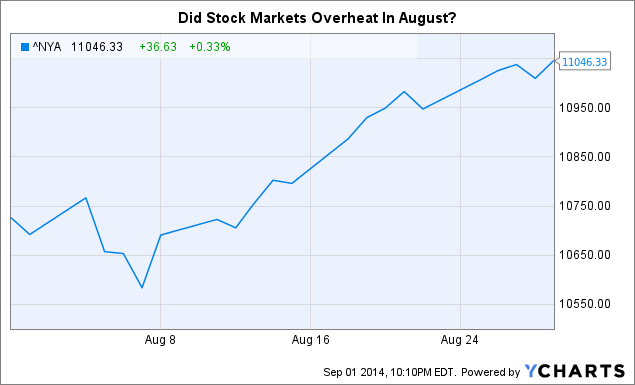
^NYA data by YCharts
Sounds highly speculative, doesn't it? That's because it is. While the phenomena has been studied in academic journals and the focus of attention from investors for years, nobody is really sure why it occurs.
Could The Dip Be "Mental"?
Of course, by now the September dip may have become a self-fulfilling prophecy. To illustrate, some investors might get jittery at the beginning of the month, knowing what September historically brings. They start to sell off their stocks and prices begin to dip.
Normally, other investors might see dipping prices as a sign to buy, after all that's how markets are supposed to work. Knowing that it's September, however, they instead see it as a sign that the dip is indeed coming.
Those investors who were slightly more confident than the first wave of sellers suddenly get cold feet too, and begin to sell off their stocks. Prices dip further, more people get nervous, and so onwards the cycle goes.
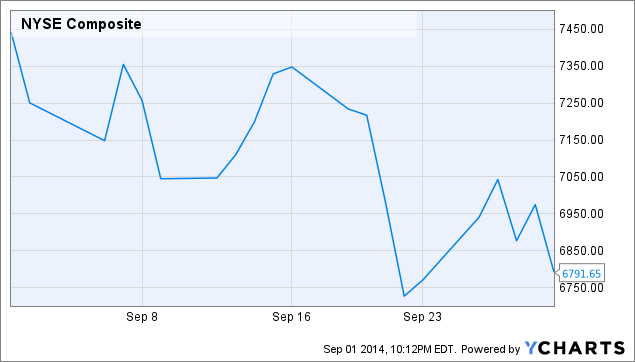
^NYA data by YCharts
Indeed, it could even be articles like this very one that contribute to and make the September dip happen. Smaller investors read these articles, get nervous, and start to sell. This makes the professionals and institutional investors get nervous and they start to sell too.
It should be noted, however, that the swoon has existed for decades, predating the age of the Internet and the influx of smaller investors into an industry that had once been dominated by experts. Professional and institutional investors should be less likely to be influenced by superstitions.
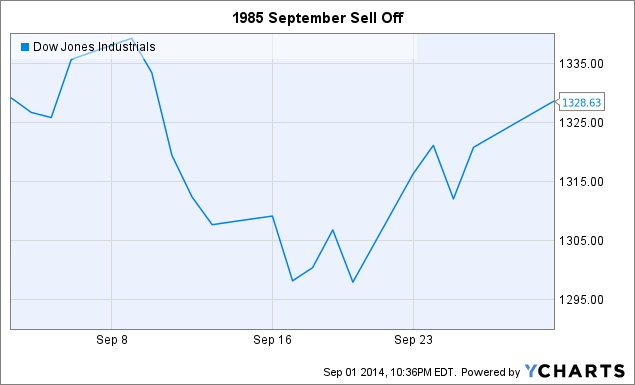
^DJI data by YCharts
Regardless, just because swoons have happened in the past, that doesn't mean one is going to happen this year. Let's look at some current conditions to see if we can learn more about what this September could bring.
Some Investors Are Indeed Getting Cold Feet
It's easy to see why investors, who normally try to be cool, calculating, and objective, suddenly dread that turn of the page on the calendar when August gives way to September.
And indeed, it seems that jittery investors may already be contributing to a self-fulfilling prophecy this year as some professional investors are already selling off.
The Wall Street Journal reported that James Paulsen, the chief investment strategist at Wells Capital Management, already expects a 15 percent drop in stocks this fall. In order to protect his portfolios and the portfolios of his clients, Mr. Paulsen is advising clients to invest overseas.
Given the tensions in Europe, the on-going effects on the wind down of quantitative easing, and the lingering doubts in China, it's hard to justify overseas markets over U.S. markets. Indeed, if anything markets overseas will likely have a tougher month than U.S. markets, should a swoon appear.
WSJ also reports that Russ Koesterich, the chief investment strategist at BlackRock who oversees $4.32 trillion in assets, is reducing his positions ahead of September. Mr. Koesterich expects the S&P 500 to drop by 8 to 10 percent this fall as markets correct themselves
Given the massive amount of assets managed by Mr. Koesterich, if he starts selling off stocks too quickly, his actions alone could weigh down on markets, again leading to a self-fulfilling prophecy.
Will There Be A September Swoon?
It's tempting to say no. After all, economic indicators are pointing up across the world. In the U.S. inflation remains low, and employment is rising. Meanwhile, economic growth has been accelerating, quarterly earnings have been great, and consumer confidence is rising.
Across the world Asian markets are shaking off a few turbulent weeks, and the European Central Bank (ECB) is meeting to discuss more stimulus measures. If this package comes through, European markets should rise, and that should send American markets higher.
No way the September Swoon could make another appearance, right?
Yet at the same time August was indeed a great month for quarterly earnings reports but perhaps markets have gotten a bit overheated. Might be time for a natural cool off.
Add in tensions in Ukraine and the Middle East, and worrisome economic data from the E.U. and China, and combined it all suggests that yet another swoon could make its appearance this year.
Any investors getting cold feet couldn't be blamed for selling off their stocks. Stocks may rise over the next few days owing to the ECB meeting and other factors, but given how fragile markets are it won't take much to derail gains.
If stocks do go through a swoon the bear markets could create some great opportunities to pick up stocks on the cheap. If early September ends up being the right time to sell, then mid-to-late September could be the right time to buy.
If a September swoon does hit and stocks start to dip, and you haven't liquidated your portfolio, it'll likely be best to hold onto your stocks. The dip has proven to generally be temporary.
Of course, as news hits the headlines you will have to reevaluate your position. For example, if a rash of layoffs is announced or a credit bubble in China pops, you'll have to adjust your strategy as that news comes to light.
Either way, if you decide to ride out September make sure you don't get cold feet and stick to your strategy. Don't sell off as soon as markets dip five percent, instead wait and let markets regain.
Another swoon may reappear, but that doesn't mean your portfolio has to suffer over the long run.
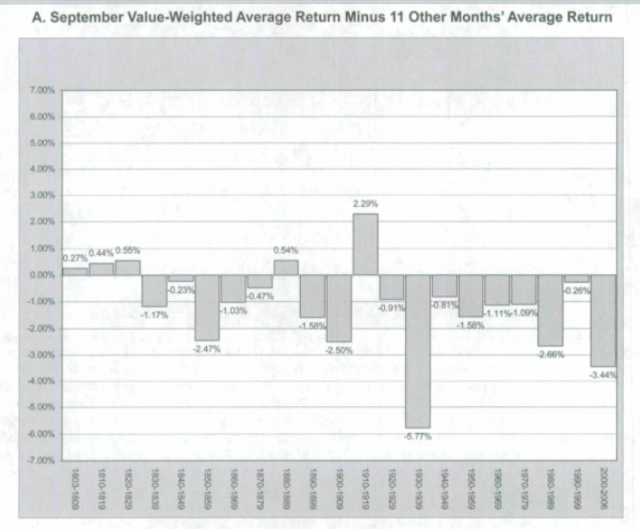
No comments:
Post a Comment